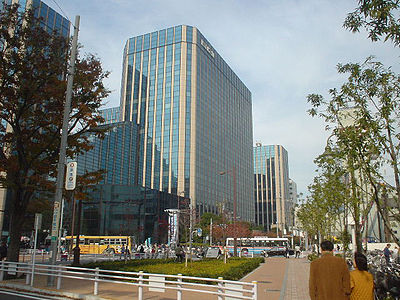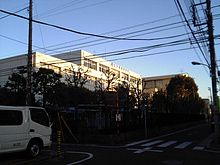- Ōmori
-
 Ōmori Belport, headquarters of Isuzu
Ōmori Belport, headquarters of Isuzu
35°34′00″N 139°44′00″E / 35.566667°N 139.733333°E
Ōmori (大森) is a district located a few kilometres south of Shinagawa, Tokyo, Japan accessed by rail via the Keihin Tohoku line, or by road via Dai Ichi Keihin. Ōmorikaigan, the eastern area of Ōmori, can be reached via the Keikyu line.
Ōmori is one of many areas in Tokyo's largest ward, Ota-ku, and was formerly home to the German International School before its relocation to Yokohama. The quality residential and retail developments that the German school attracted are obvious in the Ōmori-sannō area. Ōmori is home to the headquarters of the automotive company Isuzu, which has offices in the Belport complex a few hundred metres from Ōmori station.
Prior to its development as a convenient residential and business location, Ōmori was laced with a network of small rivers which were used by many locals for drying harvested nori (seaweed), a staple of the Japanese diet. Modern Ōmori is built on mostly reclaimed land, and is very much a traditional Shinto area; there are many shrines in the area, and during the August o-bon festival, mikoshi parades are very common.
Ōmori-sannō, to the west of Ōmori station, is an upscale neighbourhood compared to the other side of the tracks, and Ōmori-sannō is known to be traditionally an area where Japanese poets, philosophers and writers have made their home.
Ōmori was also the site of a particularly brutal Prisoner-Of-War camp during World War II, staffed by the war criminal Matsuhiro Watanabe.
Contents
Two Omori's
Ōmori has two meanings:
- Area around JR Ōmori station.
- Town of Ōmori.
While Ōmori station opened in 1876 and is widely known to outsiders, the "town of Ōmori" was renamed in 1970 and is less known, and even local residents are often confused. Broadly, the west side of JR Ōmori station is still Ōmori but generally speaking it is considered Sannō area, an uptown.
Education
Ota operates the public elementary and junior high schools in Ōmori.
Tokyo Metropolitan Government Board of Education operates Ōmori High School [1].
Private high schools include Tokyo High School.
Parks
- Heiwa-no-mori Park. Largest park in Ota-ku (99,000 m²)
- Heiwajima Park. Includes: baseball ground; barbecue park (2,200 yen for ward residents, 2,600)[1]; swimming pool (inside and outside)[2]
- Ōmori-furusato-no-hamabe Park.[3] Maritime park. Local elementary school children call it "Furuhama". Particulars: Free entrance; Closed at night; Fishing is allowed in the rocky stretch of water; Campfires are not allowed; Benches and some tables available; Drinking water; Toilets and no showers; The chlorine count usually exceeds the "suitable to swim" level so swimming is prohibited); No shade from sun, and unlike Odaiba beach, there is no shops around the beach; Parking lot is not near.
See also
References
External links
- Map of Omori Area and Sanno, Magome and Ikegami Areas from Ota-ku's ward official website.
- Sports Facilities
Neighborhoods of Tokyo Akasaka · Akihabara · Aoyama · Asagaya · Asakusa · Asakusabashi · Azabu · Daikanyama · Den-en-chōfu · Ebisu · Futako Tamagawa · Ginza · Gotanda · Hamamatsuchō · Harajuku · Hibiya · Hongō · Ichigaya · Iidabashi · Ikebukuro · Iwamotochō · Jiyūgaoka · Jinbōchō · Jūjō · Kabukichō · Kagurazaka · Kajichō · Kamata · Kanda · Kasumigaseki · Kichijōji · Koishikawa · Kugayama · Kyōbashi · Kōenji · Kōjimachi · Marunouchi · Mita · Meguro-Mita · Nagatachō · Nihonbashi · Nishi-Shinjuku · Nishikichō · Ochanomizu · Odaiba · Ogawamachi · Ōizumigakuenchō · Ōmori · Omotesandō · Ōtemachi · Roppongi · Ryōgoku · San'ya · Sendagaya · Shiba · Shibaura · Shibuya · Shimokitazawa · Shinbashi · Shinjuku · Shinjuku ni-chōme · Shiodome · Shirokane · Shirokanedai · Sudachō · Sugamo · Surugadai · Takadanobaba · Takanawa · Tamachi · Tateishi · Tsukiji · Tsukishima · Uchi-Kanda · Uchisaiwaichō · Ueno · Wakasu · Yaesu · Yayoi · Yōga · Yotsuya · Yoyogi · Yūrakuchō
Categories:- Neighborhoods of Tokyo
- Tokyo geography stubs
Wikimedia Foundation. 2010.

